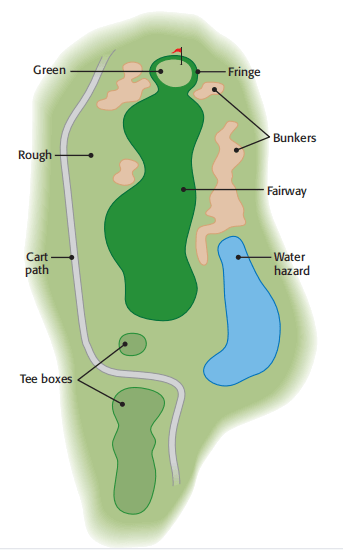Knowing the different parts of the golf course will help you plan effectively and make great shots. There are several parts a golf course but the 5 major parts are the tee, fairway, green, rough and hazards. Let’s have a look at them.
Table of Contents
Parts Of A Golf Course
Although courses do vary in type, the vast majority feature common elements. Here are the different parts of a golf course:
1. Tee box: The area from which you hit your first shot on each hole. Most courses feature multiple sets of tees to accommodate golfers of different skill levels.
The back tee boxes are used by only the best golfers; these tees extend the course to its longest possible yardage. The middle tee boxes are used by most average golfers. The forward tee boxes are used by most female and senior golfers. (All golfers play to the same green no matter which tee box they have used.)
2. Fairway: The closely mown stretch of turf between the tee and the green.
3. Cart path: The formal path throughout the course for golf carts to drive on. Keep your cart on this path unless otherwise instructed by course officials.
4. Rough: High, often thick grass that borders the fairway and surrounds the green.
5. Bunker: A hazard usually filled with sand (but sometimes grass) found mostly around greens but also on fairways.
6. Water hazard: A pond, lake, river, or stream found in the middle or to the side of a hole.
7. Fringe: The closely mown turf that encircles the putting surface; fringe grass is slightly higher than the grass of the green itself.
8. Green: The designated putting surface for each hole, where the flagstick and cup are located.
9. Out-of-bounds area: An area indicated by white stakes that is considered out of play. If a ball is hit into an out-of bounds area, a one-stroke penalty is incurred, and your next swing must be taken from where your last shot was played.

Types Of Holes
The main factor that defines a type of hole is its par. That number reflects the number of strokes it should take an experienced golfer to complete the hole. There are three types of holes: par-threes, par-fours, and par-fives. The yardage of each hole determines the par.
The following distances are general guidelines for the lengths of each type of hole. (The lengths of holes played by professionals vary from these guidelines.)
- Par-three: Up to 210 yards for women and up to 250 yards for men
- Par-four: 211–400 yards for women and 251–470 yards for men
- Par-five: 401–575 yards for women and 471–690 yards for men
You may also hear the term dogleg used to describe a par-four or par-five. That term refers to the shape of the hole, which usually bends fairly dramatically to either the right (as shown below) or the left.

What Is The Longest Golf Course?
The longest course in the United States is found in Bolton, Massachusetts. The private Pines Course at The International is 8,325 yards long. The fifth hole is a 715-yard par-five; there is also a 277-yard par-three. The 18th hole is a mere 656 yards.
Different Types Of Golf Courses
You will come across several different types of golf courses, which vary both in the types of holes they feature and in their policies regarding whom can play there.
Regulation: A regulation course is considered a full-sized course. It can consist of nine or 18 holes with full-lengthpar-threes, par-fours, and par-fives.
Executive: An executive course can be made up of nine or 18 holes, but the holes are shorter than on a regulation course.
Private: A private course is open only to members.
Semi-private: A semi-private course offers both memberships and tee times for non-members.
Public: A public course, also called a daily-fee course or a municipal course if owned and/or managed by local officials, is open to anyone.
Pitch and putt: A pitch-and-putt course is a nine- or 18-hole course with very short holes, most under 100 yards. These courses are generally open to the public.
Miniature: You use only your putter on a miniature golf course, which usually has at least nine holes and numerous fun obstacles (windmills, clown’s mouths, and so on) blocking your path to the hole.
There are also two main styles of courses:
Links: A course usually built on treeless, sandy soil alongside (or “linked” to) the sea. Some courses use this description if the land is wide open and devoid of trees, but authenticity is lacking if the course is not near the sea. The Old Course at St. Andrews, shown here, is a good example of a traditional links course.
Parkland: A course in which golf holes are defined by trees on both sides.
According to the National Golf Foundation, at the end of 2005, there were 16,052 facilities containing at least one golf course in the United States, and 11,680 of those were open to the public. The states with the most golf facilities included:
- Florida (1,075)
- California (928)
- Texas (848)
- Michigan (843)
- New York (824)



